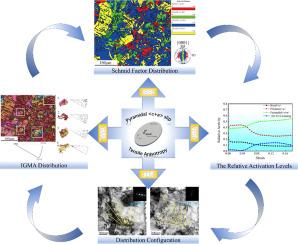基于晶体塑性分析的轧制Mg-6.3Gd-3Li-2Zn-0.5Al合金滑移主导变形机制及拉伸各向异性
IF 13.8
1区 材料科学
Q1 METALLURGY & METALLURGICAL ENGINEERING
引用次数: 0
摘要
采用粘塑性自洽(VPSC)模型和材料表征技术,分析了轧制Mg-6.3Gd-3Li-2Zn-0.5Al合金(R2和R4)的力学性能、拉伸各向异性和变形机理。结果表明:Mg-Gd-Li合金轧制后的力学性能表现出明显的各向异性,屈服强度和抗拉强度沿轧制方向最高,分别为272.3 MPa和294.5 MPa;相反,屈服强度和抗拉强度在横向(TD)分别只有214.7 MPa和253.1 MPa。各向异性随变形的增大而增大。通过调整淬火参数,分别建立了Mg-Gd-Li合金轧制拉伸变形的VPSC模型。利用VPSC模型计算了Mg-Gd-Li合金的锥体滑移,并在电子背散射衍射(EBSD)数据中进行了观测。由VPSC模型生成的应力-应变曲线和极点图与实验结果吻合良好。轧制后Mg-Gd-Li合金屈服强度各向异性的主要原因是基体滑移在不同拉伸方向上的活化程度。另一方面,在不同拉伸方向变形过程中(10-12)孪晶的激活水平是导致拉伸强度各向异性的主要原因。本文章由计算机程序翻译,如有差异,请以英文原文为准。

Slip-dominated deformation mechanisms and tensile anisotropy of rolled Mg-6.3Gd-3Li-2Zn-0.5Al alloy based on crystal plasticity analysis
In this work, mechanical properties, the tensile anisotropy, and deformation mechanisms during tensile testing of rolled Mg-6.3Gd-3Li-2Zn-0.5Al alloys (R2 and R4) were analyzed with Visco-Plastic Self-Consistent (VPSC) model and material characterization techniques. The results showed that the mechanical properties of the rolled Mg-Gd-Li alloy displayed considerable anisotropy, with highest yield strength and tensile strength along the rolling direction (RD) measured at 272.3 MPa and 294.5 MPa, respectively. Conversely, the yield and tensile strength in the transverse direction (TD) were merely 214.7 MPa and 253.1 MPa, respectively. Furthermore, the anisotropy increased with the deformation. The VPSC models for rolled Mg-Gd-Li alloy in tensile deformation were constructed, respectively, by adjusting the hardening parameters. Pyramidal <c + a> slip, which dominated the deformation mechanisms of Mg-Gd-Li alloy, was calculated via VPSC model and observed in electron backscatter diffraction (EBSD) data. The stress-strain curves and pole figures generated from the VPSC model exhibited excellent agreement with experimental results. For the rolled Mg-Gd-Li alloy, the activation levels of basal <a> slip along different tensile directions were the main cause of the anisotropy in yield strength. On the other hand, the activation levels of (10–12) twinning during deformation in various tensile orientations were primarily responsible for the anisotropy in tensile strength.
求助全文
通过发布文献求助,成功后即可免费获取论文全文。
去求助
来源期刊

Journal of Magnesium and Alloys
Engineering-Mechanics of Materials
CiteScore
20.20
自引率
14.80%
发文量
52
审稿时长
59 days
期刊介绍:
The Journal of Magnesium and Alloys serves as a global platform for both theoretical and experimental studies in magnesium science and engineering. It welcomes submissions investigating various scientific and engineering factors impacting the metallurgy, processing, microstructure, properties, and applications of magnesium and alloys. The journal covers all aspects of magnesium and alloy research, including raw materials, alloy casting, extrusion and deformation, corrosion and surface treatment, joining and machining, simulation and modeling, microstructure evolution and mechanical properties, new alloy development, magnesium-based composites, bio-materials and energy materials, applications, and recycling.
 求助内容:
求助内容: 应助结果提醒方式:
应助结果提醒方式:


